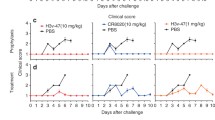Summary
The large (HA1) and small (HA2) subunits of influenza virus A/Vict/3/75 hemagglutinin were purified in denatured form by preparative electrophoresis. Both polypeptides were used to immunize mice from which monoclonal antibodies were obtained. These antibodies reacted not only with the corresponding hemagglutinin subunit but also with purified virions. When tested by radioimmunoassay against a panel of human viruses, most anti-HA1 and -HA2 antibodies behaved as subtype-specific, whereas anti-HA antibodies, raised against purified virus, were more restricted. The anti-subunit antibodies were negative in hemagglutination-inhibition and neutralization tests. The interest of these antibodies as reagents for research and diagnosis is discussed.
Similar content being viewed by others
References
Atassi MZ, Webster RG (1983) Localization, synthesis and activity of an antigenic site on influenza virus hemagglutinin. Proc Natl Acad Sci USA 80: 840–844
Becht H, Huang RTC, Fleischer B, Boschek CB, Rott R (1984) Immunogenic properties of small chain HA2 of the hemagglutinin of influenza viruses. J Gen Virol 65: 173–183
Fazekas de StGroth S, Scheidegger D (1980) Production of monoclonal antibodies: strategy and tactics. J Immunol Methods 35: 1–21
Gerhard W, Yewdell J, Frankel ME, Webster R (1981). Antigenic structure of influenza virus hemagglutinin defined by hybridoma antibodies. Nature 290: 713–716
Graves PN, Schulman JL, Young JF, Palese P (1983) Preparation of influenza subviral particles lacking the HA1 subunit of hemagglutinin: unmasking of cross-reactive HA2 determinants. Virology 126: 106–116
Green N, Alexander H, Olson A, Alexander S, Shinnick TK, Sutcliffe JG, Lerner RA (1982) Immunogenic structure of the influenza virus hemagglutinin. Cell 28: 477–487
Hirst GK (1942) The quantitative determination of influenza virus and antibodies by means of red cell agglutination. J Exp Med 75: 47–64
Klenk H-D, Rott R, Orlich M, Blodorn J (1975) Activation of influenza A virus by trypsin treatment. Virology 68: 426–439
Köhler G, Milstein C (1975) Continuous cultures of fused cells secreting antibody of predefined specificity. Nature 256: 495–497
Lindenman J (1977) Host antigens in enveloped RNA viruses. In: Poste G, Nicolson GL (eds) Virus infection and the cell surface. Elsevier/North Holland Biomedical Press, New York, pp 291–327
López JA, Guillén M, Sánchez-Fauquier A, Melero JA (1986) An antigen-binding assay to determine the specificity of monoclonal antibodies against influenza virus and mapping of epitopes. J Virol Methods 13: 255–264
Lowry OH, Rosenbrough NJ, Farr AL, Randall R (1951) Protein measurements with the folin phenol reagent. J Biol Chem 193: 265–275
Melero JA, Tur S, Carroll RB (1980) Host nuclear proteins expressed in simian virus 40-transformed and -infected cells. Proc Natl Acad Sci USA 77: 97–101
Muller GM, Shapira M, Arnon R (1982) Antiinfluenza response achieved by immunization with a synthetic conjugate. Proc Natl Acad Sci USA 79: 569–573
Niman HL, Houghten RA, Walker LE, Reisfeld RA, Wilson IA, Hogle JM, Lerner RA (1983) Generation of protein-reactive antibodies by short peptides is an event of high frequency: implications for the structural basis of immune recognition. Proc Natl Acad Sci USA 80: 4949–4953
Pereira MS (1979) Global surveillance of influenza. Br Med Bull 35: 9–14
Rosenthal JD, Hayashi K, Notkins AL (1973) Comparison of direct and indirect solid-phase microradioimmunoassays for the detection of viral antigens and antiviral antibody. Appl Microb 25: 567–573
Schulman M, Wilde CD, Köhler G (1978) A better cell line for making hybridomas secreting specific antibodies. Nature 267: 269–270
Studier FW (1972) Analysis of bacteriophage T7 early mRNAs and proteins in slab gels. J Mol Biol 79: 237–248
Towbin H, Staehelin T, Gordon J (1979) Electrophoretic transfer of proteins from polyacrylamide gels to nitrocellulose sheets: procedure and some applications. Proc Natl Acad Sci USA 76: 4350–4354
Webster RG, Kendal AP, Gerhard W (1979) Analysis of antigenic drift in recently isolated influenza A (H1N1) viruses using monoclonal antibody preparations. Virology 96: 258–264
Webster RG, Laver WG, Air GM (1983) Antigenic variation among type A influenza viruses. In: Palese P, Kingsbury DW (eds) Genetics of influenza viruses. Springer, Wien New York, pp 127–162
Author information
Authors and Affiliations
Rights and permissions
About this article
Cite this article
Sánchez-Fauquier, A., Villanueva, N. & Melero, J.A. Isolation of cross-reactive, subtype-specific monoclonal antibodies against influenza virus HA1 and HA2 hemagglutinin subunits. Archives of Virology 97, 251–265 (1987). https://doi.org/10.1007/BF01314425
Accepted:
Issue Date:
DOI: https://doi.org/10.1007/BF01314425




